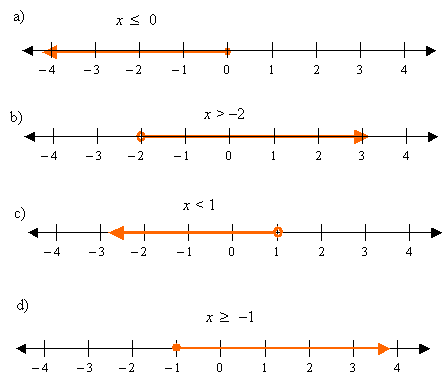OK! Enough for my the rubbish-like introduction take make a little sense but not too much sense... OMG... what I'm saying!
In this subtopic called "Solve Inequalities Using Technologies" I found out, we don't really use much technology like graphing calculator. But, we use different ways like number line method, graphing method and numeric method and 2 graph method.
First, the number line method.
For inequality sign "<" the arrow on the number line goes towards left as it is less than certain number.
For inequality sign ">" the arrow on the number line goes towards right as it is greater than certain number.
Watch this video about Graphing Inequalities on a Number Line.

From the example above we noticed one thing. A fully colored dot and a hollow dot. What is the difference?
a fully colored dot on the number lines mean the sign "≤" or "≥" depending on the direction of the arrow. A hollow dot means the sign "<" and ">" depending on the direction of the arrow.
Second, the graphing method or the 2 graph method.
By looking at the graph we can know which part of the graph is above or below the x-axis. This method provides us an image of the range where the y-values are positive or negative and thus giving us the answer of the inequalities.
If we solve the inequalities using 2 graphs method, we need to make both side of the inequalities to be equal to y then plot 2 graphs. The x-value of the intersection point for both graphs will be the answer for the inequalities.
For a clearer understanding of graphing method, I suggest you to go to this link. http://www.sosmath.com/algebra/inequalities/ineq04/ineq04.html. I think it is pretty informative and clear.
For the last method, Numerical method, I found it the best method. I do not know why, i just like it the most. That's why people says "love is blind"... haha!
First we transform the inequalities into an equation that is equal to 0. Then, we look for its x-intercept. Then we test each interval of the x-intercept.
Let's say for example the x-intercept are -6 and 2, we can try out when x<-6, the function is either positive or negative. Then the interval between -6<x<2 and x>2.
Then we look for the interval that is positive or negative, according to the sign of the inequalities in the question, and that interval will be our answer. For example, for question "solve x³+2x-1>0" we will look for the positive part of the function as the sign is greater than and vice versa for question with a less than sign.
Web resources:
Youtube, Graphing Inequalities on a Number Line, <http://www.youtube.com/watch?v=AjZzACaeIco&feature=player_embedded>
S.O.S Math, Solving Polynomial Inequalities by Graphing, <http://www.sosmath.com/algebra/inequalities/ineq04/ineq04.html>




